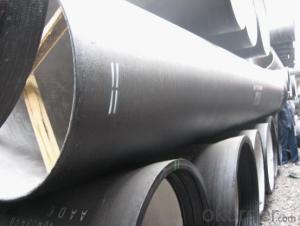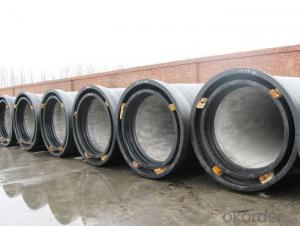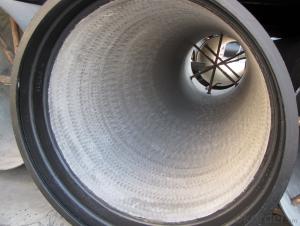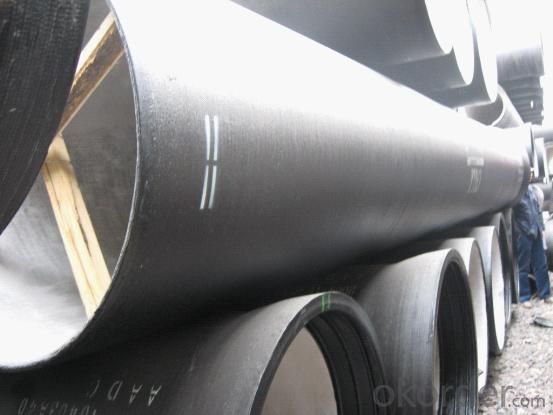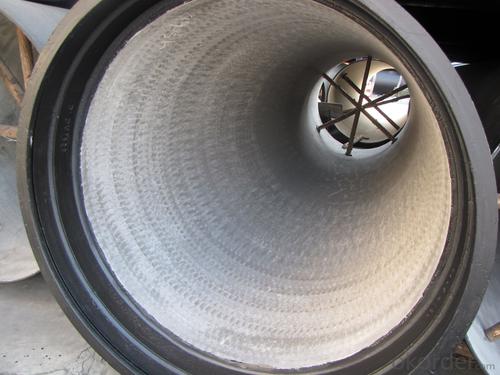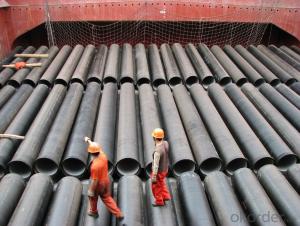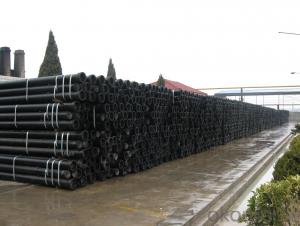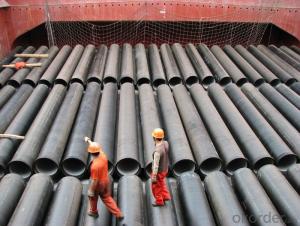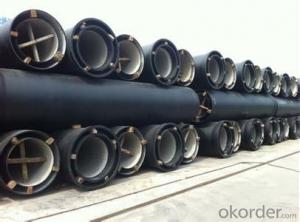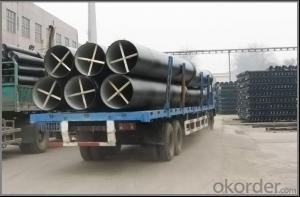Ductile Iron Pipe DN80 DN100 DN200 K8 K9 K7
OKorder Service Pledge
Quality Product, Order Online Tracking, Timely Delivery
OKorder Financial Service
Credit Rating, Credit Services, Credit Purchasing
You Might Also Like
Specifications
Quick Details
| Place of Origin: | China (Mainland) | Brand Name: | CMAX | Model Number: | T type / K type / Flange type |
| Length: | 6m / 5.7m / Negotiable | Standard: | ISO2531 / EN545 / EN598 | Application: | Potable / Sewage water |
| Diameter: | DN80~DN2200 | Shape: | Round | Hardness: | 230 |
| Pipe Wall Thickness: | standard | Pull Strength: | 420 | Yield (≥ MPa): | 300 |
| Material: | Ductile Iron | Type: | Centrifugal ductile cast iron pipe | Certification: | ISO2531 / EN545 / EN598 |
| Outer Diameter: | 80-2200 | Thickness: | standard | Specification: | DN80~DN2200 |
| |
The advantages to the customer:
Trustworthy financial strength.
One-stop shopping.
Fast and efficient service.
Coordination of shipments from multiple plants.
Specialists of the overseas shipping process.
A more competitive price.
- Q: How do ductile iron pipes perform in seismic zones?
- Due to their unique characteristics and design features, ductile iron pipes have demonstrated exceptional performance in seismic zones. These pipes possess the ability to withstand ground movements, vibrations, and other seismic forces that may arise during an earthquake. The flexibility inherent in ductile iron pipes enables them to absorb and distribute the energy generated by seismic activities. This flexibility prevents the pipes from fracturing or breaking when subjected to intense ground shaking. Moreover, the high strength and resilience of ductile iron make it highly resistant to damage caused by ground movements. Furthermore, ductile iron pipes are designed with joints that are restrained, providing increased stability and resistance against seismic forces. These joints can accommodate small lateral movements without compromising the integrity of the pipeline system. Additionally, the restrained joints prevent the pipes from becoming disconnected or misaligned during seismic events, guaranteeing the uninterrupted flow of water or other fluids. In seismic zones where the ground is more susceptible to liquefaction or soil settlement, ductile iron pipes are often installed using methods that enhance their stability. For example, deep embedment techniques or the inclusion of thrust blocks at bends and fittings increase the pipes' resistance to lateral forces exerted by the ground. Regular inspection and maintenance further enhance the performance of ductile iron pipes in seismic zones. Periodic assessments can identify any potential weaknesses or damages that may have occurred during seismic events, enabling prompt repairs or replacements. Overall, ductile iron pipes have a well-established track record of reliable performance in seismic zones. Their flexibility, strength, and design characteristics make them highly resilient against seismic forces, ensuring the safe and uninterrupted supply of water or other fluids, even in earthquake-prone areas.
- Q: What are the different methods for testing ductile iron pipe?
- There are several methods available for testing ductile iron pipe to ensure its quality and reliability. These methods include: 1. Hydrostatic Testing: This is the most common method used for testing ductile iron pipe. It involves filling the pipe with water and pressurizing it to a specified level. The pipe is then inspected for any leaks or deformations under the applied pressure. Hydrostatic testing helps determine the pipe's ability to withstand internal pressure without failure. 2. Tensile Testing: This method involves subjecting a sample of the ductile iron pipe to a gradually increasing tensile load until it fractures. The test measures the ultimate tensile strength, yield strength, and elongation of the material. Tensile testing helps evaluate the pipe's mechanical properties and its ability to withstand tension without breaking. 3. Hardness Testing: This method measures the hardness of the ductile iron pipe using various techniques such as Brinell, Rockwell, or Vickers hardness tests. Hardness testing provides information about the material's resistance to deformation, wear, and fatigue. It helps assess the pipe's durability and resistance to external forces. 4. Impact Testing: This method involves striking a notched sample of the ductile iron pipe with a pendulum or falling weight to measure its impact resistance. The test determines the material's ability to absorb energy during sudden loading or impact. Impact testing helps evaluate the pipe's ability to withstand accidental impacts or dynamic loads. 5. Ultrasonic Testing: This non-destructive testing method uses high-frequency sound waves to detect internal defects or discontinuities in the ductile iron pipe. Ultrasonic testing can identify voids, cracks, or inclusions that may affect the pipe's structural integrity. It helps ensure the pipe's soundness and reliability. 6. Magnetic Particle Testing: This method is primarily used for detecting surface or near-surface defects in the ductile iron pipe. It involves applying a magnetic field to the pipe and then applying magnetic particles to the surface. Any defects present will cause the magnetic particles to gather and form visible indications. Magnetic particle testing helps identify surface cracks, laps, or other defects that may affect the pipe's performance. These different testing methods help ensure that ductile iron pipe meets industry standards and specifications, ensuring its quality and reliability in various applications.
- Q: How much is the installation of cast iron pipe drainage 1 meters?
- Water supply pipe is the first choice, with high cost performance. Compared with the PE pipe, from the installation time, ductile pipe PE pipe installation is simple and rapid, and after the installation of internal and external bearing pressure better;
- Q: Are ductile iron pipes suitable for railway crossings?
- Railway crossings can indeed utilize ductile iron pipes. Ductile iron, a robust and long-lasting material, finds extensive use in numerous applications, which include water and sewage systems. Its exceptional tensile strength and flexibility allow it to withstand heavy loads and vibrations, both of which are commonly encountered in the vicinity of railway crossings. Moreover, ductile iron pipes exhibit exceptional resistance to corrosion, making them particularly valuable in areas prone to moisture and exposure to diverse weather conditions. This resistance guarantees the pipes' durability, ultimately reducing the need for maintenance and replacement, thus cutting costs. Furthermore, ductile iron pipes are renowned for their effortless installation and versatility. They seamlessly integrate with other pipe types and fittings, facilitating their incorporation into the overall railway crossing infrastructure. However, it is important to bear in mind that the suitability of ductile iron pipes for railway crossings hinges on various factors, such as load requirements, soil conditions, and specific project specifications. Consulting engineering professionals and adhering to industry standards and regulations is vital to ensure the appropriate selection and installation of ductile iron pipes for railway crossings.
- Q: How is ductile iron pipe recycled?
- Ductile iron pipe is typically recycled through a process called reclamation. This involves collecting the used pipe, cleaning and removing any impurities, and then melting it down to form new ductile iron products. The recycled ductile iron can be used to manufacture various items such as new pipes, fittings, and construction materials, providing a sustainable and environmentally-friendly solution for its disposal.
- Q: Are ductile iron pipes resistant to chloride-induced corrosion?
- Indeed, chloride-induced corrosion can be effectively resisted by ductile iron pipes. Ductile iron, a variant of cast iron fortified with magnesium for enhanced malleability and crack resistance, possesses a ferritic microstructure that grants exceptional resilience against chloride-induced corrosion. The interaction between chloride ions in water or soil and the metal surface can lead to the development of corrosion byproducts like rust. Nonetheless, the inclusion of magnesium in ductile iron forms a protective coating, preventing the infiltration of chloride ions and thus impeding corrosion. Consequently, ductile iron pipes are well-suited for a broad spectrum of applications, including water supply and sewerage systems, wherein exposure to chlorides is prevalent.
- Q: How are ductile iron pipes connected or jointed together?
- Ductile iron pipes are typically connected or jointed together using various methods such as flanged joints, push-on joints, mechanical joints, or restrained joints. These methods ensure a secure and leak-free connection between the pipes, providing a reliable and durable pipeline system.
- Q: Are ductile iron pipes suitable for airport runway drainage?
- Ductile iron pipes are indeed a suitable choice for airport runway drainage. Their exceptional strength and durability enable them to endure heavy loads and extreme conditions commonly encountered in airport operations. Moreover, these pipes possess corrosion resistance, a vital characteristic for drainage systems exposed to diverse chemicals and environmental factors. Additionally, their smooth inner surfaces facilitate efficient water flow and prevent blockages that could disrupt the drainage system. Furthermore, ductile iron pipes are effortless to install and maintain, thus establishing themselves as a dependable option for airport runway drainage systems.
- Q: What is the cost of ductile iron pipe compared to other pipe materials?
- The cost of ductile iron pipe can vary depending on factors such as size, length, and project requirements. Generally, ductile iron pipe tends to be more expensive than alternatives like PVC or HDPE pipes. Ductile iron pipe is renowned for its strength and durability, making it suitable for water distribution, wastewater systems, and industrial piping. Its robustness and longevity contribute to its higher cost compared to other materials. In contrast, PVC and HDPE pipes are often more affordable due to lower production and material costs. They are also lightweight, easy to install, and resistant to corrosion, resulting in cost savings during installation and maintenance. While ductile iron pipe may have a higher upfront cost, its superior strength and longevity can lead to long-term savings by reducing the need for frequent repairs or replacements. The choice of pipe material should consider project requirements, budget constraints, and the expected lifespan of the infrastructure.
- Q: Can ductile iron pipes be used for firefighting systems?
- Yes, ductile iron pipes can be used for firefighting systems. Ductile iron pipes are known for their strength, durability, and ability to withstand high pressure. They are commonly used in various applications, including firefighting systems, due to their resistance to corrosion and their ability to handle the flow of water efficiently.
Send your message to us
Ductile Iron Pipe DN80 DN100 DN200 K8 K9 K7
OKorder Service Pledge
Quality Product, Order Online Tracking, Timely Delivery
OKorder Financial Service
Credit Rating, Credit Services, Credit Purchasing
Similar products
Hot products
Hot Searches
Related keywords
